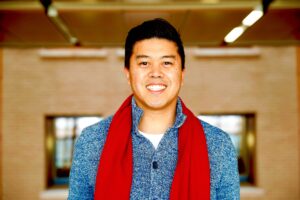As we recognize APIDA Heritage Month, we are centering the thoughts and voices of APIDA faculty and staff in the UW–Madison campus community. We caught up with Tony DelaRosa, a doctoral student in Education Leadership & Policy Analysis, to learn his perspective on the observance and APIDA heritage.
Note: Responses have been edited for clarity
What does APIDA Heritage Month mean to you?
APIDA is a very broad term. How can we celebrate APIDA Heritage while also recognizing and celebrating the broad spectrum of identities that fall within the APIDA umbrella?

Having 48 countries and 2300+ languages, how can we do our community justice? It is recognizing that a month is not enough time to celebrate the beauty and complexity of the APIDA community, and committing to amplify APIDA narratives and histories 365 days per year.
One of the best strategies in honoring APIDA narratives is to ensure that we amplify local stories. For Wisconsin, according to the 2018 AAPI Data report, “the largest AAPI ethnic groups in Wisconsin include Hmong (56,447), Chinese (30,331), Indian (30,278), Filipino (15,853), Korean (15,664), and Japanese (7,585).”
With this data in mind, how can we amplify the histories and stories of these communities, especially that of the Hmong community which has fought for over 20 years to pass Hmong and Asian American education in the state? Also, to complicate this data, how are we looking at stereotyped narratives, and providing counterstories that challenge the stereotypes about these communities? Localizing how you tell APIDA stories and sharing counterstories are two ways that we can celebrate and honor our community.
What do you want the community to learn about APIDA Heritage Month?
I want people to know that APIDA people observe this month in different ways. Some people celebrate by showcasing their culture and history in festivals, food, poetry, and art, and others like myself choose this month to teach people about the APIDA resistance movements that have contributed to the fight for Asian American studies. For me, APIDA Heritage Month is a practice of maintaining and sharpening my ethnic memory, which I lost through the assimilation processes. Revisiting the 1960s Ethnic Studies and my Filipino history of anti-martial law every year around this time reminds me that there is always something to learn about movements. The revisiting helps expand my own identity as an Asian American freedom fighter and unveils how time opens up doors for new lenses.
Are there any APIDA leaders, past or present, you admire? Why?
I admire Dr. Allyson Tintiangco-Cubales. She is an Ethnic Studies Professor and Practitioner at San Francisco State University, where Ethnic Studies began. I met her through following her work whileteaching and coaching teachers. Because of her, I’m finding ways to explore decolonization, self-determination, and cross-ethnoracial solidarity building. I admire how she creates scholarship, tools, and opportunities that are community-responsive – which is why I started my path into becoming a professor. The world needs healing, and her work contributes to that in both small and large ways.